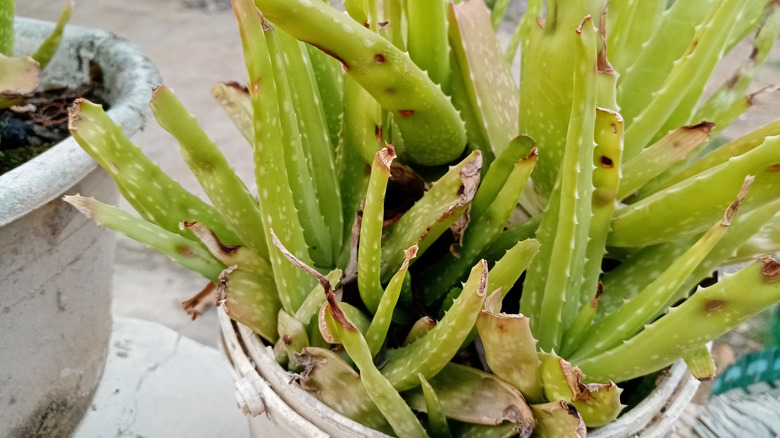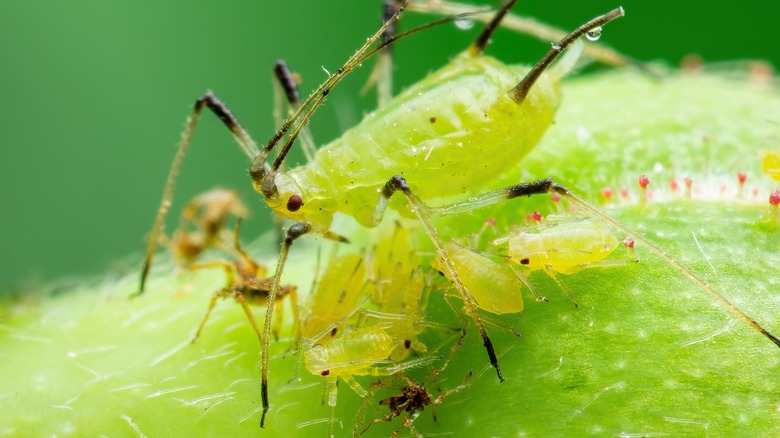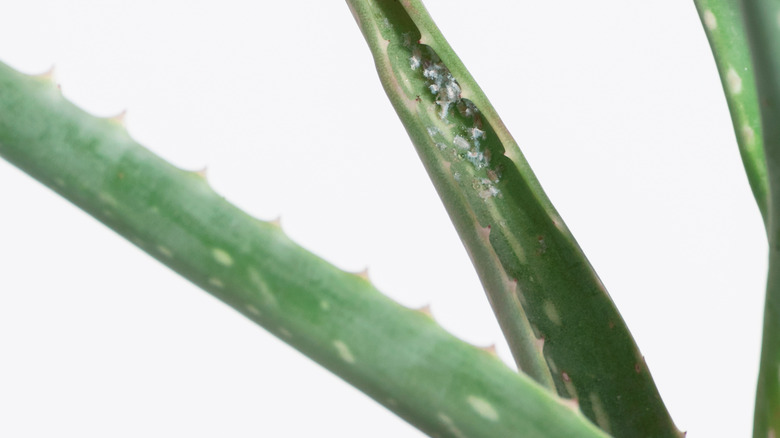How To Treat Your Aloe Plant When It's Infected With Pests
Your aloe plant could be one of the easiest plants to manage. That's why, when you start to notice changes in it, like its color becoming less vibrant and even yellow, you may be concerned with what's happening to it. Though it's a rather low-maintenance plant overall, infestations, especially from insects like aphids and mealybugs, can significantly damage your plant's health. There are some situations where you can preserve the plant's health by taking action to remove or control the pest infestation, including through the use of insecticides. Other times, physically removing the pests is an option, though more challenging.
Pests can interfere with the aloe plant's ability to grow and thrive, and they show this in different ways, depending on the type of pest present. For example, mites are noted for their ability to feed on the plant itself, chomping away at stems and roots. It can be hard to see mites since they're so small, but the destruction of the plant itself can imply their presence. Pests like spider mites can create webbing on plants, while mealybugs will create a film-like stickiness. The plant may also become very thin and sickly looking. These bugs like to suck out the fluid from the plants and often hide on the underside of the leaves, making it rather hard to notice the damage right away. Once you identify the type of pest, the next step is to address it with the best specific care possible.
Strategies for removing aphids from aloe plants
One of the most common culprits that cause aloe infestations is aphids. Aphids are very small bugs that tend to be green or black in color — found on the plant's leaves and the top layers of soil. One option is to take the plant outdoors to use the high-pressure from a hose to rinse off the pests from the plant. You can also pluck off the pests if you see them.
Insecticidal soaps can also help kill off the insects themselves while keeping the plant safe. You'll need to do this frequently and according to the manufacturer's direction. Another way to keep aphids off aloe vera plants is to use dish soap. You can use several tablespoons of mild dish soap added to a spray bottle of water, which can be another treatment option. The soap works to wash away the protective wax-like coating on the pest, causing it to dehydrate and eventually die. Be careful with this method so as not to overdose the actual plant with soap, though. Spray just the leaves and rinse them off, protecting the soil as much as possible.
How to keep mealybugs off aloe vera
For mealybugs, another common problem for aloe plants, some of the previously mentioned strategies may work — with a few variations. These bugs often show up when an aloe vera plant is overwatered. They're hard to see since they can hide deep in the spine of each leaf. They tend to be very small, white pests with a fuzzy appearance.
If this seems to be the pest on your aloe vera plant, start your treatment by washing off the leaves without drenching the soil. You can also use a combination of rubbing alcohol and dish soap. Add a few drops of dish soap to a clean spray bottle of water. Then, add a few tablespoons of rubbing alcohol with a 70% concentration. Spray on the leaves and leave it there. Insecticides are another treatment option for mealybugs that can help when there's ample infestation. A few other strategies include dipping a Q-tip into alcohol and applying it directly to the surface of the leaf.
Because these bugs can get deep into the soil, it's wise to repot the plant. Remove as much of the dirt as possible and rinse off your aloe thoroughly before placing it into a sterilized pot. Finally, be sure to keep good air circulation in the area to help support the plant's recovery. Getting rid of mealybugs and other pests takes ongoing effort and close observation of your plant.


